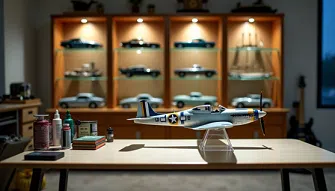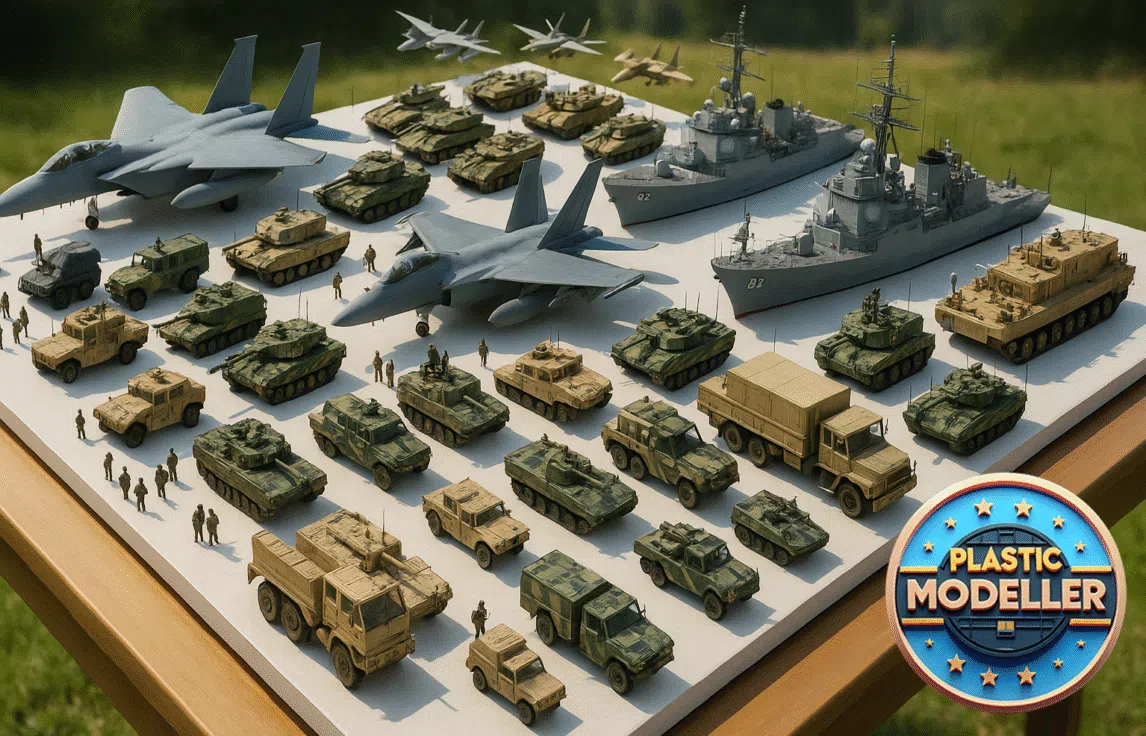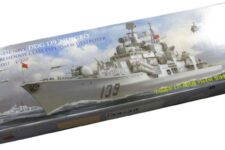
Scale modeling transforms ordinary spaces into extraordinary miniature worlds, capturing the essence of vehicles, aircraft, buildings, and historical moments in perfect detail. Whether you’re drawn to military vehicles, classic cars, or architectural marvels, starting a scale model collection offers endless possibilities for creativity and craftsmanship. A well-curated scale model collection can reflect your passion and dedication.
A well-organized and properly displayed collection elevates your scale models from simple hobby pieces to museum-quality exhibits. However, many beginners struggle with collection planning, workspace setup, and professional display techniques that showcase their hard work effectively.
Creating a scale model collection is not only about assembling models but also about sharing your passion with others.
Your scale model collection can become a reflection of your interests, showcasing your creativity and skill as a modeler.
Consider how to display your scale model collection effectively, as this enhances the overall presentation and appreciation of your work. As you embark on your scale model collection, think about the themes and styles that resonate most with you.
This comprehensive guide walks you through everything you need to know about starting and maintaining an impressive scale modeling collection. From choosing your collection theme and creating an organized workspace to building professional displays and connecting with fellow enthusiasts, you’ll learn the essential steps to build a collection worth showcasing.
Choosing a theme for your scale model collection can help guide your purchases and make it more cohesive.
Planning Your Scale Model Collection
Success in scale modeling begins with thoughtful planning and clear direction. Before purchasing your first kit or setting up your workspace, taking time to establish a solid foundation for your collection will save you both time and resources in the long run.
Choosing Your Collection Theme
The key to building a meaningful scale model collection lies in selecting a theme that resonates with your personal interests. Whether you’re passionate about World War II aircraft, classic sports cars, or architectural landmarks, your theme should reflect what truly excites you. Many successful collectors focus on specific eras, manufacturers, or types of vehicles.
Consider these popular collection themes:
- Military vehicles from a specific conflict
- Racing cars from a particular decade
- Aircraft from your favorite air force
- Ships from historical naval battles
- Architectural landmarks from your region
Setting Collection Goals
Smart goal-setting transforms your modeling ambitions into achievable milestones. Start by determining the scope of your collection – whether you want to focus on quantity, quality, or a specific series completion. Your goals might include mastering new techniques, completing a certain number of models per year, or assembling a comprehensive collection of variants for a particular subject.
As you refine your scale model collection, remember that each piece tells a story, reflecting your journey as a modeler.
Remember that successful collections often start small and grow systematically. Consider beginning with one or two models that align with your chosen theme, allowing you to develop your skills and refine your interests before expanding further.
Effective budgeting ensures that you can continue to expand your scale model collection over time without financial strain.
Budgeting and Space Requirements
Consider how to protect your scale model collection from dust and damage while displaying them effectively.
When designing your workspace for your scale model collection, ensure it fosters creativity and organization.
Expanding your skills will enhance the quality of your scale model collection, making it more impressive over time.
Organizing your tools efficiently is key to maintaining the quality of your scale model collection.
Scale modeling doesn’t have to break the bank, but it does require careful financial planning. Entry-level costs typically include basic tools, paints, and your first kit, which can range from $30 to $100 for a complete starter set. As your collection grows, consider allocating a monthly budget for new acquisitions and supplies.
As your scale model collection grows, so should your storage solutions to keep everything manageable.
Space planning is equally crucial. A dedicated workspace of at least 3×2 feet will accommodate most building projects, but display space requires more careful consideration. Factor in the scale of your chosen models – 1/72 aircraft require less space than 1/32 scale, while 1/35 tanks need different display configurations than 1/700 ships. Consider investing in proper display cases or shelving units that protect your models from dust while showcasing them effectively.
When planning your display area, think about lighting, temperature control, and accessibility for cleaning and maintenance. Many collectors find that vertical storage solutions and wall-mounted displays help maximize available space while creating impressive visual presentations.
Creating an Organized Workspace
A well-organized workspace serves as the foundation for successful scale modeling projects. The right setup not only enhances your modeling experience but also protects your valuable tools and materials while maximizing efficiency.
Essential Storage Solutions
An effective storage system forms the backbone of any modeling workspace. Clear, accessible storage prevents damage to delicate parts and keeps supplies within easy reach. Consider implementing these proven storage solutions:
- Plastic bins with dividers for small painted pieces
- Clear drawers for frequently used tools and supplies
- Dust-proof cases for works in progress
- Modular storage units for paints and adhesives
- Humidity-controlled containers for moisture-sensitive items
A well-organized workspace will directly impact the quality and enjoyment of your scale model collection.
Tool Organization Systems
Documenting each piece in your scale model collection will enhance its historical significance.
The key to maintaining workflow momentum lies in smart tool organization. Position your most-used tools within arm’s reach while keeping specialized equipment safely stored but accessible. A rotating carousel organizer proves invaluable for frequently used items like brushes, knives, and basic tools.
Consider mounting a magnetic tool bar above your workspace for metal tools and implementing a dedicated brush holder to protect delicate bristles. Tool organization should evolve with your needs – start simple and expand as your collection grows.
Workspace Layout Design
Your workspace layout should promote both efficiency and comfort. Position your cutting mat in the center of your work area, leaving a three-inch margin around the edges for frequently used tools. Proper lighting plays a crucial role – install adjustable task lighting to eliminate shadows and reduce eye strain.
Create designated zones for different activities:
- Primary building area with cutting mat and essential tools
- Painting station with proper ventilation
- Assembly area for larger projects
- Storage zone for works in progress
Consider incorporating a mobile workstation element, such as a rolling tool chest or portable organizer, to adapt your space for different project needs. This flexibility allows you to maximize limited space while maintaining organization.
Remember to implement environmental controls, especially if your workspace is in a basement or garage. A dehumidifier can protect your tools from rust, while proper ventilation systems safeguard your health during painting and gluing operations.
Building a Professional Display System
The professional presentation of your scale models can transform a simple collection into a museum-worthy display. A well-designed display system not only protects your valuable pieces but also creates an impressive visual impact that enhances their appeal.
Display Case Selection
Quality display cases serve as the foundation of your presentation system. When selecting cases, consider these essential features:
- UV-resistant acrylic or tempered glass construction
- Secure locking mechanisms for valuable pieces
- Adjustable shelving for flexibility
- Proper depth clearance for detailed models
- Easy access for cleaning and maintenance
The size of your display case should accommodate both current pieces and future additions. Consider cases with neutral backgrounds that won’t compete with your models for attention. Five-sided acrylic cases offer excellent visibility while providing superior protection from dust and environmental factors.
Creating a digital inventory for your scale model collection ensures organization and easy access.
Lighting Techniques
Strategic lighting dramatically enhances the visual impact of your scale models. LED lighting systems have become the standard for professional displays, offering several advantages over traditional options. Position your lights to eliminate harsh shadows and highlight intricate details.
Color temperature plays a crucial role in presentation. Opt for neutral white lighting (around 4000K) to maintain true colors and detail visibility. Avoid warm lights that can create an orangey tint or cool lights that might wash out subtle paint variations. Consider installing adjustable lighting systems that allow you to control brightness levels and create different moods for your display.
Environmental Controls
Protecting your scale models requires careful attention to environmental factors. Temperature stability is crucial – maintain your display area between 65-75°F (18-24°C) to prevent warping or damage to delicate parts. Install a reliable humidity monitoring system to keep relative humidity between 45-55%.
Modern display systems often incorporate built-in environmental controls. Consider investing in cases with integrated humidity regulation or adding separate humidity control devices to your display area. Position your displays away from direct sunlight and heat sources to prevent fading and material degradation. Regular monitoring of these conditions ensures long-term preservation of your valuable collection.
Documenting Your Collection
Preserving the legacy of your scale modeling collection requires more than just careful assembly and display. Proper documentation ensures your collection’s value, history, and craftsmanship are recorded for years to come.
Lighting plays a crucial role in showcasing your scale model collection, enhancing its visual appeal.
Photography Best Practices
Professional documentation begins with high-quality photography. Creating compelling images of your scale models requires attention to both technical and artistic elements. Essential photography equipment includes:
- DSLR or high-quality digital camera
- Sturdy tripod for stability
- Macro lens capability
- Light diffusion box or tent
- Neutral background material
- Remote shutter release
Position your models against a clean, seamless background to eliminate distractions. Natural lighting often produces the best results, but if using artificial light, ensure it’s diffused to prevent harsh shadows. When photographing details, maintain a consistent aperture setting between f/10 and f/16 for optimal depth of field.
Maintaining your scale model collection in optimal conditions will preserve its integrity and value.
Digital Inventory Management
Systematic tracking of your collection prevents confusion and helps maintain organization as your collection grows. Digital spreadsheets offer a flexible, searchable solution for inventory management. Include essential details like manufacturer, scale, purchase date, and condition ratings.
Modern collection management apps provide additional features like photo integration and value tracking. Consider cloud-based solutions that offer secure backup and accessibility across devices. Regular updates to your inventory ensure accurate records, especially when acquiring new pieces or participating in trades.
Creating Collection Catalogs
Transform your documentation into a comprehensive catalog that tells the story of your collection. Follow these steps for professional catalog creation:
- Establish a consistent naming convention
- Create detailed model descriptions
- Include build dates and modifications
- Document paint schemes and materials used
- Add historical context for each piece
- Maintain restoration or repair records
Digital catalogs offer advantages like easy updating and sharing capabilities. Consider using specialized collection software that combines inventory management with catalog features. These tools often include barcode scanning, photo galleries, and customizable fields for detailed documentation.
Remember to back up your documentation regularly and store copies in multiple locations. Whether using cloud storage or external drives, protecting your collection’s documentation is as important as protecting the models themselves.
Connecting with the Modeling Community
Building connections within the scale modeling community can transform your hobby from a solitary pursuit into an enriching social experience. The collective knowledge and support of fellow enthusiasts can accelerate your growth and provide invaluable insights into the craft.
Finding Local Model Clubs
Local modeling clubs serve as excellent starting points for connecting with fellow enthusiasts. Organizations like IPMS (International Plastic Modelers Society) maintain comprehensive databases of local chapters worldwide. These clubs often provide structured environments for learning, sharing techniques, and showcasing your work.
The impact of your scale model collection can be amplified through effective networking.
When searching for local clubs, utilize specialized club finder tools on modeling organization websites. Many clubs welcome new members with open arms and offer benefits like:
- Monthly meetings and build sessions
- Access to experienced modelers
- Group purchases for supplies
- Exclusive workshop opportunities
- Local competition participation
Online Communities and Forums
The digital landscape offers numerous platforms for scale modeling enthusiasts. Popular forums like Britmodeller, Scale-models.co.uk, and Hyperscale have become virtual workshops where modelers share their expertise. Each platform offers unique strengths – some excel in aircraft modeling discussions, while others focus on military vehicles or naval subjects.

Active participation in these communities proves invaluable for both beginners and experienced modelers. Regular engagement helps you stay updated on new techniques, kit releases, and industry trends. When joining online communities, focus on meaningful interactions rather than passive browsing. Share your work-in-progress photos, ask specific questions, and offer constructive feedback to others.
Participating in Model Shows
Model shows represent the pinnacle of community engagement in scale modeling. These events combine competition, education, and networking opportunities in one venue. To make the most of show participation, follow these essential steps:
- Research upcoming shows in your region
- Prepare your models for display or competition
- Document your build process for discussion
- Pack appropriate transport materials
- Bring business cards or contact information
- Plan questions for vendors and fellow modelers
Face-to-face interactions at shows often lead to lasting connections within the modeling community. Studies suggest that 95% of modelers consider in-person meetings crucial for establishing long-term professional relationships. Shows also provide opportunities to examine award-winning models up close, learning techniques that might not be apparent in photographs or videos.
Many shows feature workshops, demonstrations, and vendor areas where you can explore new products and techniques firsthand. Take advantage of these learning opportunities by engaging with presenters and asking detailed questions about their methods. The knowledge gained from these interactions often proves more valuable than the competitive aspects of shows.
Sharing your scale model collection online can attract like-minded enthusiasts and potential collaborators.
Remember that community involvement extends beyond simply displaying your work. Volunteer opportunities at shows, club meetings, and online forums help strengthen the modeling community while expanding your network. Whether judging at competitions, helping with show organization, or mentoring newcomers, giving back to the community enriches the hobby for everyone involved.
Conclusion
Scale modeling represents more than just a hobby – it’s an art form that rewards patience, precision, and dedication. Starting your collection might seem daunting at first, but following a systematic approach makes the journey both manageable and enjoyable. Proper planning, workspace organization, and professional display techniques lay the groundwork for a collection worth showcasing.
Success in scale modeling stems from attention to detail, both in model building and collection management. Documentation preserves your work’s legacy, while proper display systems protect and highlight your achievements. These elements, combined with active community participation, create a rich and fulfilling modeling experience that grows more valuable over time.
Networking within the modeling community can open doors for expanding your scale model collection. Joining local clubs can provide support and valuable insights for your scale model collection.
Remember that every master modeler started with their first kit. Focus on building your skills gradually, maintain high standards for your workspace and displays, and connect with fellow enthusiasts who share your passion. Your scale modeling collection will become a source of pride and accomplishment, telling unique stories through miniature masterpieces that capture moments in time.
Participating in model shows can greatly enhance the visibility of your scale model collection. Reflecting on your scale model collection journey can inspire others to pursue their own modeling passions.
Each scale model collection is unique, shaped by individual experiences and preferences. Your scale model collection will tell a story of creativity and passion, connecting you to others in the community.









